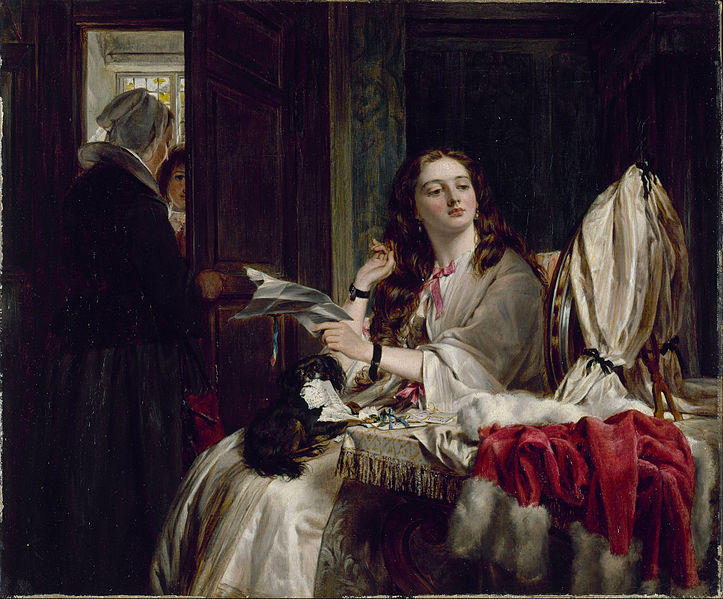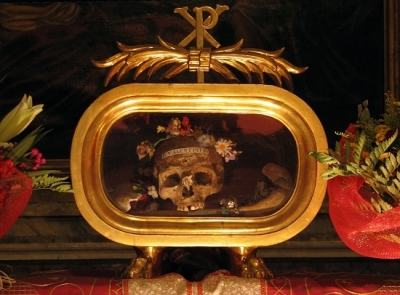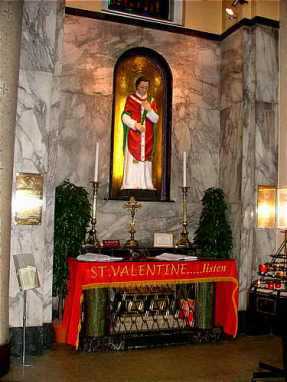
The Victorians were very good at taking an idea and running with it. The present day commercialisation of Valentine’s Day can be laid at their feet. And the man to thank (or blame) is Sir Rowland Hill and the Penny Black stamp. More anon.
The origins of Valentine’s Day are buried in the mists of time. Some claim its roots were in Ancient Rome, where they celebrated the fertility festival of Lupercalia from 13th to 15th February. Pope Gelasius I is said to have declared the 14th February to be Valentine’s Day in an attempt to reclaim this festival from the Romans.
But who was Valentine? There were three possible candidates, two of whom, Valentine of Rome and Valentine of Terni, were both Christian martyrs who were associated with the 14th of February.
The front-runner for most historians is the Catholic priest, Valentine of Rome, who was martyred in 269 and made a saint in 496. Originally his relics were in the church and catacombs of San Valentino in Rome and this was an important pilgrim site in the Middle Ages. During the time of Pope Nicholas IV, the relics were moved to the church of Santa Prassede. Today, his flower-crowned skull is exhibited in the Basilica of Santa Maria in Cosmedin in Rome.


There are rival claimants for the honour of possessing the body of St. Valentine but it is popularly believed that some relics are found at Whitefriar Street Carmelite Church in Dublin, Ireland. A famous Carmelite preacher, Fr. John Spratt, visited Rome in 1835 and was so popular that Pope Gregory XVI decided to make his church a gift of St. Valentine’s body. On November 10, 1836, the Reliquary containing the remains arrived in Dublin and were brought in solemn procession to Whitefriar Street Church where they were received by Archbishop Murray of Dublin. With the death of Fr Spratt interest in the relics died away but during a major renovation in the church in the 1950s/60s, they were returned to prominence with an altar and shrine. Now it is a place of pilgrimage for young Irish lovers.
A Potted History of Valentine Verse
It was Geoffrey Chaucer, in the 14th century, who first associated the day with romantic love, at a time when courtly love was flourishing. His poem, Parlement of Foules, includes the lines:
For this was on seynt Volantynys day
Whan euery foul comyth there to chese his make.
The British Library holds the earliest surviving written Valentine greeting. The Duke of Orleans was imprisoned in the Tower of London following the 1415 battle of Agincourt. He wrote these lines to his wife:
Je suis desja d’amour tanné
Ma tres doulce Valentinée
The oldest surviving Valentine’s letter in English is also held in the Library. It dates from 1477 and was written by Margery Brews to her fiancé, John Paston. Margery describes him as her “right well-beloved Valentine”.
In the 17th century, the Immortal Bard gave these lines to Ophelia:
To-morrow is Saint Valentine’s day,
All in the morning betime,
And I a maid at your window,
To be your Valentine.
The most famous, Valentine poem appeared in a collection of nursery rhymes printed in 1784:
The rose is red, the violet’s blue,
The honey’s sweet, and so are you.
Commercialisation
In the late 18th century cards were handmade. Lovers would decorate paper with romantic symbols including flowers and love knots, often including puzzles and lines of poetry. Those who were less inspired could buy volumes that offered guidance on selecting the appropriate words and images to woo their lover. These cards were then slipped secretly under a door, or tied to a door-knocker.

But it was my dear friends the Victorians who took Valentine’s Day to another level. With Sir Rowland Hill’s reduction in postal rates with the invention of the Penny Black postage stamp in 1840, the number of Valentines posted increased, with 400,000 sent just one year after the Penny Black was introduced. Cards could now be posted anonymously, probably the reason for the sudden appearance of racy verse in an era otherwise synonymous with prudishness!

One of the largest collections of Victorian Valentines is held at the Museum of London. The 1,700 cards are the archive of Jonathan King, who ran a card-making business in London. It features a huge array of designs, verses and sentiments that were all the rage for Victorian lovers.
Not all Valentine’s cards were romantic however; some, referred to as ‘Vinegar Valentines’, were designed to insult. One example features a cartoon of a woman with a large nose. Under the title ‘Miss Nosey’ are the following lines:

On account of your talk of others’ affairs
At most dances you sit warming the chairs.
Because of the care with which you attend
To all others’ business you haven’t a friend.
Around the middle of the 19th century, the cards crossed the Atlantic where they became hugely popular. More advanced printing technology in America meant that more elaborate cards were produced. In 1913 Hallmark Cards produced their first Valentine’s card, representing a key development in the commercialisation of Valentine’s Day.
It will be interesting to see if the Valentine card survives in this digital age, as the cost of postage steadily increases and few want to spend the time in a shop choosing a card when it can all be done with the click of a button. I hope it is a tradition that doesn’t die but then I’m an old romantic at heart!



Thank for your interesting and historical account of St. Valentine’s Day . I enjoyed your post very much!
LikeLike
Thank you – it was fun to write.
LikeLiked by 1 person
really interesting.loved the Vinegar Valentines…never heard of them!
LikeLiked by 1 person
I hadn’t either!
LikeLike
You romantic, you! Lovely post.
LikeLiked by 1 person
Only for one day – then it’s back to normal!!
LikeLike
Great article. I have never known any of this. Thanks so much for sharing 🙂
LikeLiked by 1 person
I didn’t either. Now will have to go to Whitefriar St. church to say hello to Valentine.
LikeLike
Really love post, Pam!
LikeLiked by 1 person